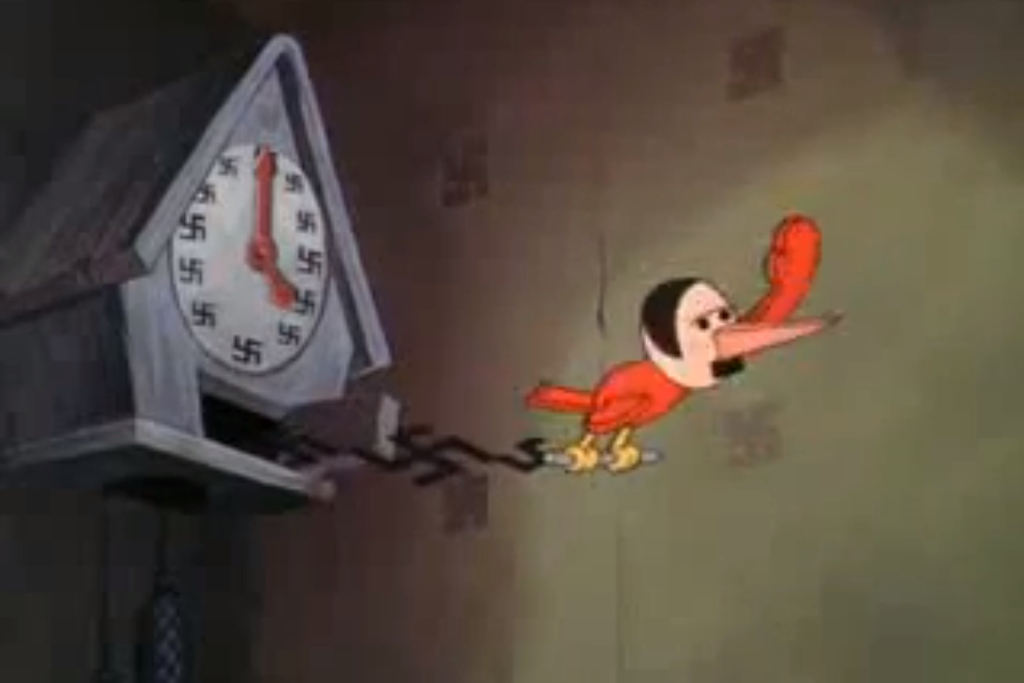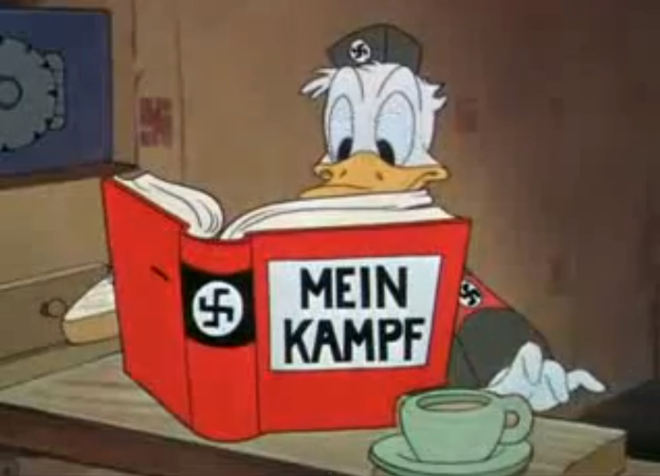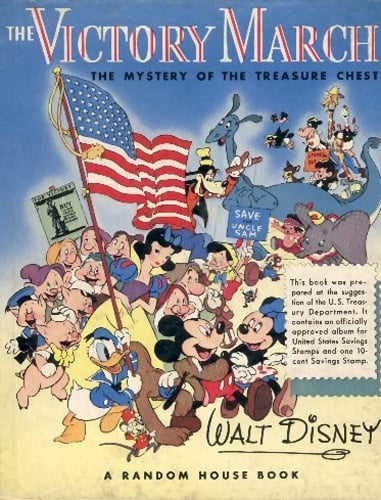The Dark Days Of Disney: Slavery, Propaganda, Animal Cruelty, And More
They have a film called The Story Of Menstruation in their archives, too. :|

When your company has been making films since 1923, it is inevitable that, as sensibilities shift and time insists on remaining linear, you will find your back-catalogue strewn with quite objectionable content.
And although the Disney company has been under fire in recent years for racial stereotyping – a lazy Jamaican crab in 1989’s The Little Mermaid touts the benefits of not needing a job; the introductory song to 1992’s Aladdin sets up “home” as “where they cut off your ear if they don’t like your face”; all of Pocahontas is just terrible – back during the heyday of Walt Disney Productions, the inappropriate content really flourished: Propaganda films, a light-hearted look at plantation slavery, actual animal murder for the sake of a documentary, replacing the Bible with Mein Kampf, and the burning of a Catholic Church. You know, classic Disney.
Let’s begin with a charming 1946 short, The Story of Menstruation.
–
The Story Of Menstruation (1946)
The Story Of Menstruation wasn’t crammed between ‘Chip and Dale’ adventures on Saturday Disney or anything like that; it was an educational film screened in health classes to school-aged students. But a few troubling factors still stand out. Most notably, this film was commissioned by International Cello-Cotton Company, whose stock and trade was the Kotex range of feminine hygiene products (the company are better known now as Kimberly Clark). This commercial coupling is extra evil in that, as the film was screened, students were given a booklet named Very Personally Yours, covering off the Kotex range of products and imploring students not to use tampons – as these were a product of competitors Procter and Gamble, and therefore not a happy purchase.
While these sexual education films are squeamish/horrifying at best, The Story Of Menstruation is filled to the brim with troubling messages, such as the following sage advice for avoiding depression: “No matter how you feel, you have to live with people – and yourself”, and the visual depiction of yucky, red menstrual blood as a pure, snow-white flow.
The film also presses the importance of keeping up appearances, despite the beautiful, natural process tearing through your insides (“It’s smart to keep looking smart!”). It reduces the resulting pain to “a little twinge”, while advising you not to “throw yourself off schedule by getting over-tired, emotionally upset, or catching cold.” There seemed to be a real emphasis on not catching a cold during this magical time, to the point of instructing on shower temperature. (Fun fact: “Not only can you bathe, but you should bathe”!)
Of course, intercourse and reproduction are daintily skipped over (read: not mentioned once during the entire film), although The Story Of Menstruation does mark the first time the word “vagina” was uttered in a motion picture, so there’s that in its favour. I believe Rob Schneider’s The Hot Chick was the second to hit this milestone although, as we all know, this film has dated terribly.
–
Der Fuehrer’s Face And Education For Death: The Making Of The Nazi (1943)
By 1943, children all around this glorious, spinning globe were enchanted by the Walt Disney Company, and the magical worlds they created. The Silly Symphonies and Mickey Mouse shorts produced throughout the ‘30s were popular and lucrative enough that Walt had been able to step into feature length animation — and by “step into” I mean “invent”. Between 1938 and 1942 the company had pumped out Snow White and the Seven Dwarfs, Pinocchio, Fantasia, Dumbo and Bambi, so naturally the next big brainstorming session concluded with the decision to portray the lovable, easily-flappable Donald as a subservient Nazi.

It wasn’t as crazy a leap from Bambi to Der Fuehrer as it may first seem. By 1942, the studio was in a state of disarray: many animators had been drafted, a lot of previous markets were now cut off to Disney product due to the war, and there was the matter of a pesky little deal Disney made with the US government, to create propaganda films to help with the war effort.
Approximately 500 of Disney’s 550 employees were working exclusively on war-related films, the easy familiarity of Disney’s characters now being used to rally troops and increase support for the cause. During this time, the company created hundreds of shorts, with output ranging from dry educational films for Navy cadets, to Donald Nazi-saluting a photo of Hitler. Donald, for his part, seems to have been the Disney character most caught up in the war effort: a series of five 1942 cartoons see him get drafted (the first of these, Donald Gets Drafted, seems heavily anti-military, despite the Government funding), while more than a few Donald films from this period existed solely to encourage viewers to pay their income tax in order to keep the war effort rolling.
The furthest they went with the Donald character (aside from when he purportedly called WB’s Daffy Duck a “stubborn nigger”) was in Der Fuehrer’s Face, released on New Year’s Day in 1943 because, Happy New Year! Donald is portrayed as a slightly resistant/drone-like Nazi, living in a town where everything — clouds, trees, telegraph poles — is swastika-shaped. Donald is dragged out of bed by, oh, just Himmler, Goebbels and Mussolini, who force him to read Mein Kampf, give him piss-weak war rations, then kick him to a factory, where his job seems to be to make artillery shells and salute pictures of Hitler. This repetitive regime results in a manic episode where Donald begins twisting his body into the shape of a swastika, before flipping out and tripping balls, his world now a spinning rush of singing shells, shrieking snakes, screeching smoke whistles and untold horror. As this is a cartoon, and also 1943, it turns out Heir Duck’s army flirtation was but a dream, with the cartoon ending with a tomato thrown at Hitler’s face – as per film and television laws in the ‘40s.
Oh, and Disney won an Academy Award for the piece.
Two weeks later they followed up with the even more disturbing Education for Death: The Making of the Nazi, which sees a little boy, Hans, gifted to Adolf Hitler and the Nazi Party, who raise the adorable tyke to see that “weakness has no place in a soldier”. Young Hans takes this to heart and embarks on a book-burning spree, swapping out copies of the Bible for Mein Kampf, burning a Catholic Church, and marching throughout his teen and adult years as a “good Nazi”, until he marches right into one of a row of identical graves – marked by nothing but a swastika and his helmet.
No tomato gag this time, just the full-force of the Nazi regime. And you thought Bambi’s mother was brutal. Disney was just setting you up for this.
–
The Victory March and Seven Wise Dwarfs (1941-1942)
More war-time Disney magic, although this campaign was all about bypassing the adults and hitting the real impressionable minds of the day: the children. This time, war stamps and war bonds are the point of order, first off with a special book for children, which encourages the collection (purchase) of War Savings stamps.
The Victory March book was published in 1942, available for free, and wrapped in a colourful cover depicting some of Disney’s most lovable creations brandishing the Stars and Stripes, marching merrily towards victory. Pinocchio is picketing with a ‘Save Uncle Sam’ sign — a glazed-looking Goofy controlling his strings — while Mickey and Minnie lead the march, their thirst for Nazi blood palpable (Mickey got the taste when he brutally smote the personified broom in Fantasia). The cover reads “this book was prepared at the suggestion of the U.S treasury department”, with sarcastic emphasis no doubt intended on the word ‘suggestion’.

Inside, the book tastefully conveys the Big Bad Wolf of Goldilocks fame, and three meeker-looking wolves as German, Japanese and Italian fascists, who steal Donald’s single savings stamp – indicating that even Donald wasn’t paying attention to the messages in his propaganda films. Basically, this was the Dollarmites scam of the ‘40s.
Feeling the War Savings message really should be served to children across several formats, Walt Disney also reprised the Seven Dwarfs, one of his most celebrated creations at that point. This time, Disney stripped each of them of their one defining trait, instead painting them equally as the Seven Wise Dwarfs.
And what makes the seven dwarfs wise, aside from their ability to brainwash a princess into staying in their pokey cottage for years as a live-in maid? Well, in the four years that had passed since their first cinematic outing, the dwarfs had moved from the dark depths of the mystical forest to the outskirts of Ottawa, working there in an undisclosed mine. After uncovering a mess of gemstones, our diminutive friends do what all miners do, and immediately invest in Canadian War Savings Certificates — an extremely wise and patriotic move.
The short film doesn’t shine any light on whether, four years on, Snow White and Prince Charming had yet had the awkward discussion where she questions his initial reasons for making out with her corpse. That’s more of a three-months-in kind of conversation.
–
Song Of The South (1946)
Definitely the most controversial film in Disney’s canon – quite a feat when you have a cartoon child systematically torching churches in your catalogue – Song Of The South has never been released in its entirety on home video, and met widespread condemnation upon its 1946 release. Mainly due to Disney taking the Seven Dwarfs’ cheerful “whistle while you work” motif and importing it directly to black plantation slaves.
Set in the South during the Reconstruction-era (i.e. post-abolishment of slavery), it nevertheless paints protagonist Uncle Remus firmly as a slave, albeit the willing, acquiescing type. The easy relationship between master and slave was too much for many to handle, as were the clichéd, racist mannerisms of many of the share-croppers, topped off by Disney-style skirting over any of the major issues the film dabbles in/exploits for commercial gain.
Disney weren’t blind to the controversy the film would arouse upon release; that’s why they chose to set the film in a time of post-abolition – although the delineation was needlessly muddy. Time Magazine warned the film would “enrage all educated Negroes”, and the National Negro Congress picketed screenings, while The National Association for the Advancement of Colored People issued a statement which read in part: “In an effort neither to offend audiences in the North or South, the production helps to perpetuate a dangerously glorified picture of slavery. Making use of the beautiful Uncle Remus folklore, Song of the South unfortunately gives the impression of an idyllic master-slave relationship which is a distortion of the facts.”
Remember, this public outrage was in 1946, so the content has only become more offensive. The film was reissued ten years later, before being sensibly buried in the ‘60s to avoid the studio becoming an easy target during the civil rights turmoil. Disney announced in 1970 that it had “permanently” been retired, although there it was, was back in cinemas, in 1972.
Song Of the South has never enjoyed a home video release in America – it would be a troubled addition to any child’s collection – although numerous cinematic re-releases have occurred, the most recent of which was in 1986, to mark the film’s 40th anniversary. In 2010, Disney CEO Robert Igor dismissed Song Of The South as “fairly offensive” and “antiquated”, suggesting a re-release is unlikely.
But should he ever wish to argue the merits of this frightfully offensive film, he could point out that actor James Baskett, who portrayed Uncle Remus, was the first black man to win an Academy Award – which, we smugly counter, almost makes up for the fact he wasn’t allowed to attend his own film’s premiere: Atlanta was still racially segregated in 1946.
–
White Wilderness (1958)
Given the previous entry, it would be easy to surmise by its name that this 1958 film was another unfortunate racial mis-step. White Wilderness, however, is simply an Academy Award-winning nature documentary about the curious habits of the adorable lemming. Awww, bless!
Filmed over three years, the documentary is notable for its critical levels of cuteness — until a shocking scene in which a rush of lemmings roll/slide/leap off a cliff-face into the Arctic Ocean. The narrator stresses this is simply a gang of migrating lemmings approaching a body of water and attempting to swim across, but popular culture has since rendered the scene as proof of a mass lemming suicide — an aspect which has become the rodent’s defining feature.
The video game, Lemmings, is entirely about this mindless trait, while the Blink-182 song of the same name deals with Mark Hoppus’ strained relationship with a girl… but also references “lemmings to the sea”, so there’s that. The problem with this misconception is not that this “suicide” scene has been misread, or infused with human motives – it’s that the entire scene was staged, with the hapless lemmings being pushed off the cliff-face by the film-makers.
This wasn’t simply cruel opportunism though; the footage was shot in Canada, not by the Arctic Ocean – with the decidedly non-native lemmings imported by the Disney crew. The film-makers basically treated these adorable rodents as neglected plush-toys, tossing them over cliffs, coercing them down steep, rugged terrain, and placing them on a rotating platform – leading directly to the great blue beyond below.
It took a 1982 report on Canada show The Fifth Estate to uncover the ruse; while researching animal cruelty in Hollywood, journalist Bob McKeown discovered the footage had been pieced together and manipulated to look natural. Regardless, the film is yet to be stripped of its Academy Award, and the lemming still has to deal with the daily occurrence of well-adjusted rodents stressing that “the clouds will lift any day now man, you’ll see”.
–
Nathan Jolly is the Editor of The Music Network, Australia’s number one music industry magazine/embedder of that video where Bieber raps.